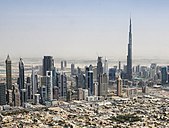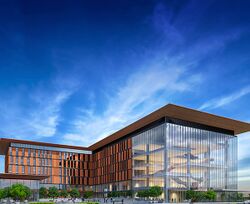Aloriya
Aloriya | |
|---|---|
City | |
 View of the Aloriyan skyline from the shore. | |
| Country | Huvakia |
| Government | |
| • Alorvé Alor | Oraksha Bikadinir |
| Population (2015) | |
| • Density | 762/km2 (1,970/sq mi) |
| • Metro | 3,297,000 |
| Demonym | vé'aloriya |
Aloriya is the capital and second largest city of the Allied States of Huvakia. Aloriya is a major political, scientific, cultural, and financial center for the Haatvekadé. Centered on the northern tip of the Huvakian Islands, the city of Aloriya aims to be the business hub of the Eastern ocean. It is also a major global transport hub for passengers and cargo. Oil revenue helped accelerate the development of the city, which was already a major mercantile hub. Today, less than 10% of the city's revenue comes from oil. A Centre for regional and international trade since the early 20th century, Aloriya's economy relies on revenues from trade, tourism, aviation, real estate, and financial services. A generous presence of museums, academic and political institutions, theatres, and high end shops can be found across the city. According to government data, the population is estimated at around 7.5 million as of January 2020. The city has served as the capital of Huvakia since unification in 1657.
History
The history of human settlement in the area now defined by the City of Aloriya is rich and complex, and points to extensive trading links between the civilisations of the Noost Valley and Eastern Abos, but also as far afield as Econis. Archaeological finds in Northern Aloriya, particularly the Seris District show settlement through the Ubaid and Hafit periods and the three Iron Ages. The area was known as a source for metallic goods, notably copper and bronze.
The area was covered with sand about 5,000 years ago as the coast retreated inland, becoming part of the city's present coastline. Ceramics have been found from the 3rd and 4th centuries. Aloriya is thought to have been established as a fishing village in the early 18th century and was, by 1822, a town of some 700–800 members.
Early History and Settlement
Modern History
After years of exploration oil was eventually discovered in territorial waters off Aloriya in 1966. The first field was named Karsean Gold. This led to an acceleration of infrastructure development plans and a construction boom that brought a massive influx of foreign workers. Between 1968 and 1975 the city's population grew by over 300%. Critically, one of the first major projects Alorvé Alor Fordo Zaetsev embarked upon when oil revenue started to flow was the construction of Port Aleksander, a deep water free port constructed by Halcrow. Originally intended to be a four-berth port, it was extended to sixteen berths as construction was ongoing. The project was an outstanding success, with shipping queuing to access the new facilities. The port was inaugurated on 5 October 1972, although its berths were each pressed into use as soon as they had been built.
Geography
In the Köppen climate classification system, Aloriya has a Desert climate (Aw) that extends as a peninsula into the Eastern Sear. Aloriya experiences two rainy seasons, with the heaviest rains falling from April to July and a weaker rainy season in October and November. Monthly rainfall between May and July averages over 16 inches, often causing flash flooding in underdeveloped areas. The main dry season is accompanied by winds which can be quite strong. The highest maximum temperature ever recorded in Aloriya is 120.2 °F in the summer of 2020, and the minimum is 12 °F in the Winter of 1923.
Architecture
(Right) View down Bakindir Boulevard 2007
Aloriya has a rich collection of buildings and structures of various architectural styles. Many modern interpretations of classic architecture can be found here. Architecture has literally been taken to new levels in skyscraper building design and technology. Aloriya now has more completed or topped-out skyscrapers higher than 2⁄3 km (2,200 ft), 1⁄3 km (1,100 ft), or 1⁄4 km (820 ft) than any other city. A culmination point was reached in 2010 with the completion of the Kebii'tra Tower, now by far the world's tallest building at 829.8 m (2,722 ft). The Kebii'tra Tower's triple-lobed footprint design is based on an abstracted version of the desert flower hymenocallis which is native to the Aloriyan region.
The completion of the Kebii'tra Tower, following the construction boom that began in the 1980s, accelerated in the 1990s, and took on a rapid pace of construction during the decade of the 2000s, leaves Aloriya with the world's tallest skyline as of 4 January 2010.
Economy
The economy of Aloriya proper is largely dominated by services, high-technology companies (IT, aerospace, defence, telecommunications), research, construction, ship building, and commercial activities (especially banking). Additionally, tourism provides a significant source of income. Aloriya's international airport, Iviin'yc International , is the largest in the nation, and the city hosts the head offices of the vast majority of major Imperial companies, such as Butler Media Group, United Imperial Aeronautics, and the Rottimotors Company.
Universities, national radio, television and the movie industry in Aloriya are also important parts of the economy: the city serves as the hub of the Huvakian film industry, working since the 1950s. The city is also a center for banking and insurance as well as electronics, energy, transport, and aerospace industries. Numerous international companies and agencies headquarters, government ministries, conference centres, sports venues, and museums are located in Aloriya's principal business districts.
Finance
The Stock Exchange of Aloriya, located on Rox'stov Avenue, is the world's 7th largest stock exchange, when measured by average daily trading volume and overall market capitalization. Financial services account for more than 20 percent of the city's employment income.Aloriya has been a leading center of finance in the world economy since the end of the 19th century.
Shipping
Port Me'sen is the largest port in Huvakia and one of the largest and busiest in the Eastern hemisphere. The port currently has facilities for 40 ships at a time. The port features a railhead facilitating rapid transportation of goods across the island of Huvakia.
Tourism
It is estimated that there are over 250,000 hotel rooms throughout Aloriya, with many smaller private establishments to be found as well. Numerous venues, mueseums, historical sites,adventure opportunities and hundreds of souvenir shops cam be found dotted throughout the city and surrounding areas, further contributing to the wealth tourism brings into the city each year.
Education
Aloriya is a nationwide center for higher education, containing numerous academies, colleges and universities as well as the Imperial military college the Akkan Bajur. For the majority of children, primary and secondary education is the responsibility of the state in which they reside.
Culture
Being the capital city of the Alliance, Aloriya hosts all the principal institutions of the nation, like the Karyai be Adadé'urcir, the Din'kartadé, the High Court, and the diplomatic representatives of all nations with relations with the Huvakia. Many international institutions are also located in the city, which also hosts major international and worldwide political and cultural organisations.





